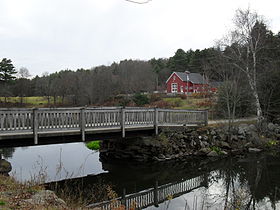Blackstone River and Canal Heritage State Park
| Blackstone River and Canal Heritage State Park (at site of "Wacentug") | |
| Massachusetts State Park | |
|
River Bend Farm,
Blackstone River and Canal State Park |
|
| Country | United States |
|---|---|
| State | Massachusetts |
| Region | Worcester County |
| Municipality | Uxbridge and Northbridge |
| River | Blackstone River |
| Location | 287 Oak Street (Visitor Ctr) |
| - elevation | 450 ft (137 m) |
| - coordinates | 42°05′40″N 71°37′23″W / 42.09444°N 71.62306°WCoordinates: 42°05′40″N 71°37′23″W / 42.09444°N 71.62306°W |
| Area | 1,066 acres (431 ha) |
| Website: Blackstone River and Canal Heritage State Park | |
The Blackstone River and Canal Heritage State Park is a part of the state park system of the Commonwealth of Massachusetts, managed by the Massachusetts Department of Conservation and Recreation (DCR). This 1,000-acre (4.0 km2) park "recalls the role of canals in transporting raw materials and manufactured goods between emerging industrial centers." The Blackstone River and Canal Heritage State Park at Uxbridge, Massachusetts, is the midpoint of the Blackstone River Valley National Heritage Corridor of the National Park System. The Blackstone River and Valley is where the industrial revolution was born in America. The southern entrance to this state park is the site of the historic Stanley Woolen Mill, currently being redeveloped for commercial and tourism. The Native American Nipmuc name for the village here was "Wacentug", translated as "bend in the river".
Transportation of goods from the upper Blackstone Valley was a growing concern by 1818. Teamsters drove huge wagons of textile goods to Woonsocket and to Worcester. John Brown, a Providence Merchant, envisioned the Blackstone Canal from the late 18th century. The Erie Canal was built in Upstate New York, just prior to the construction of the Blackstone Canal. The need for inland transportation from Worcester to Providence finally gave way to an inland waterway, the Blackstone Canal (1828). The 45-mile (72 km) canal connected Worcester to Providence, the closest port. One theory holds that rival industrialists may have prompted the building of the canal to "restrict water rights" for competitors (water powered mills). The canal was built by imported Irish laborers, who worked on the Erie Canal and settled here. It was completed in 1828. The canal was a simple ditch alongside the Blackstone River with a dirt tow path for boats to be pulled by horses. A granite lock stands at Goat Hill, and Uxbridge was the overnight stopping point. The canal connected inland Worcester mills on the Blackstone and Providence where thousands of tons of textiles could be exported all over the world. But, by 1832, the Boston and Worcester Railroad began to carry freight to Boston and the role for the canal diminished. Similar canals were built in the first half of the 19th century including others that have become National Historic Corridors, such as the Illinois and Michigan Canal in northeast Illinois.
...
Wikipedia


